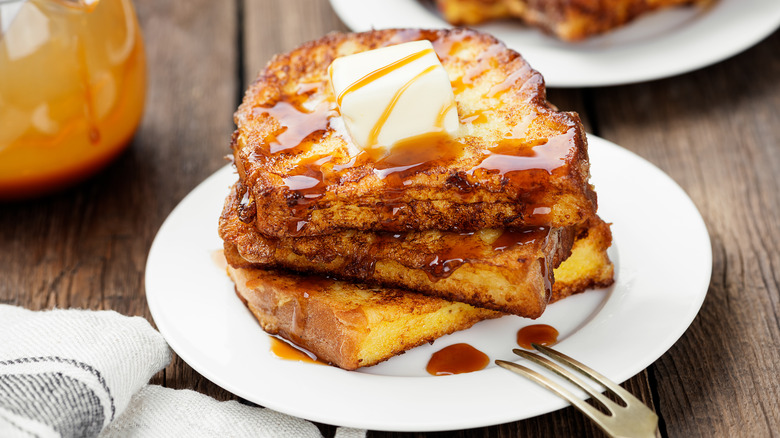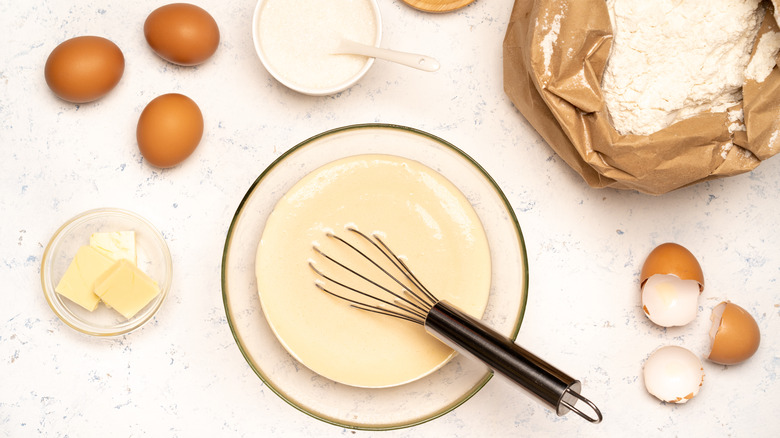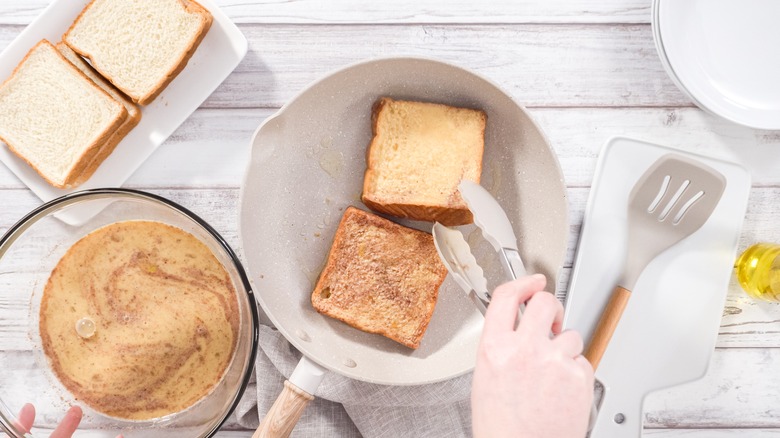Flour Is The Key To Making Impossibly Fluffy French Toast
For a dish that essentially consists of just bread, milk, eggs, and butter, French toast manages to feel like a real treat of a breakfast or brunch dish. The process is simple enough, involving quickly soaking the bread in the egg mixture before frying it in a hot skillet for a crisp yet custardy result. But if you've ever been disappointed by a soggy texture or less-than-fluffy result, then the solution is probably already in your pantry: flour.
Whisking a little all-purpose flour into the liquid mix is a simple step but one that can hugely improve the texture when it comes to making French toast. It thickens the liquid, turning it into more of a traditional-style batter, which means the coating clings better to the bread. As a result, the French toast browns more evenly, and develops a delightfully fluffy finish for a superior slice.
Another advantage of using flour is that it's an inexpensive pantry staple, so you don't need to go shopping for any hard-to-find ingredients. And it's an addition that brings impressive results, with hardly any extra effort involved — always a bonus for any easy weekend brunch dish.
Flour gives French toast a creamy taste and fluffy texture
As well as improving the texture, all-purpose flour also stops French toast from tasting overly eggy, giving a creamier flavor to the finished dish. It doesn't take much flour to achieve the desired results. Just a quarter-cup for a three-egg batter, which will make up to 12 slices of the crunchy, fluffy toast.
The easiest way to make the batter is to whisk the flour in with the milk (or cream or half-and-half if you prefer a richer flavor) and then whisk in the eggs as well as sugar and any other ingredients you want to add, such as vanilla, cinnamon, and a little salt to enhance the overall flavor. If you find that the flour tends to clump, then make a paste with the flour and a small amount of milk before whisking in the rest of the milk, eggs, and other ingredients. You could even add a little melted butter to the batter if you fancy an extra crispy coating.
Once soaked, the bread slices will be ready for turning when they become crispy and golden brown in the skillet and the floury batter is cooked; it should take around two to three minutes on each side. And if you have any slices left over, they freeze very well and can be reheated in a hot skillet, toaster, or microwave for French toast on-demand.
More ways to improve the texture of French toast
French toast can be made with different types of bread for a variation of flavors and textures, but richer bakes, such as challah or brioche, tend to produce the fluffiest results. If you fancy an extra-crispy exterior to the toast, try dipping the soaked bread slices in crushed cornflakes and ground almonds to form a crunchy coating before frying them. The textural contrast is a real treat.
To keep the coating tasty as well as crispy, try different seasonings in addition to the usual cinnamon and vanilla. Cloves, mace, and nutmeg all add warm, feisty flavors — while a little grated lemon zest adds bright, citrusy notes. And French toast is ridiculously good with a splash of Irish whiskey if you fancy adding a boozy boost to the batter mix to really start your weekend in style. The flour tip will make the flavorful coating stick even better for great texture as well as taste.
When it comes to frying the slices, butter is, of course, delicious, but it can burn easily with its lower smoke point. Oil gives a more even texture as it can be heated to higher temperatures, but try using equal amounts of oil and butter for the best of both worlds. Or go for clarified butter or ghee for a luxurious flavor that still keeps the evenly browned finish. Yes, it's a little more effort, but it's well worth it for pillowy perfection.



